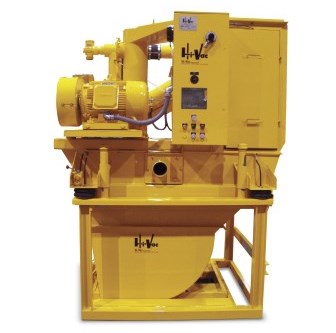Meeting New Silica Removal Standards: Think Outside the Box
February 22, 2017

Beginning in April 2016, silica particulates began to receive focused attention unlike anything that had been seen for years. The reason for the increased emphasis on silicates was a new guideline published by OSHA indicating that silica particulates present in any industrial environment must be reduced dramatically by June 2018. Indeed, the new amount of permissible silicates is comparable to a small sugar packet sitting in a football stadium. It is an extremely aggressive standard.
Reducing silica particulates so drastically in a relatively short period of time has placed a lot of stress on a wide range of industries, including concrete product manufacturing, foundries, jewelry manufacturers, cut stone manufacturers, and glass manufacturers. The issue is not simply a matter of reducing the silica dust present in these plants and factories. OSHA 81 FR 16285 also requires a high level of monitoring on the part of companies that are impacted. Along with constantly monitoring silica levels in the atmosphere, companies have also been asked to monitor employee health, specifically to monitor if silicosis and lung cancer prevalence decreases.
According to OSHA, all of the trouble these new guidelines are causing is well worth the time and expense. Referencing OSHA’s initial report, the total expense of adhering to the new guidelines would represent an investment of $1,029,782,000. Included in this estimate is the purchase of respirators, tools and manpower to assess exposure, training the workforce so that they can meet the new guidelines collectively, creating a regulated area if silicates cannot be avoided, and creating a written plan to help keep silica particulates at a minimum. OSHA reported that every year there were 642 cases of silica-related deaths and 918 cases of silica-related illness. The expense of these deaths and illnesses can cost up to $8,686,913,000, so based on OSHA logic, companies will actually save $7,657,131,000 with these new standards in place.
Click here for information about the PBS Toronto event, May 16-18, 2017
Despite this seemingly fail-safe logic, many associations have argued against the lower standards. There are indications that despite what OSHA has reported, there are very few silica-related deaths and illnesses, and lowering the silica levels to the new standard will not dramatically impact workers’ health. The expense to try to meet OSHA’s new guidelines represents, for smaller companies, a nearly insurmountable obstacle in the way of profitability. Meanwhile, even the way plant workers are going to be cleaning up dust from floors and equipment is going to have to change.
Until these new guidelines were passed, factories, plants, and foundries kept the floor clean by sweeping or shoveling. These methodologies are no longer going to be feasible based on the new standards, because sweeping and shoveling can increase the amount of dust in the air, even as it removes the dust from surfaces. It is more important than ever to rid the work environment of silicates, but the process just got more complicated at the worst possible time.
Thinking Outside the Box
One viable solution to the silica removal issue is to invest in an industrial vacuum system. Particularly valuable are vacuum systems that offer a superior air-to-cloth ratio and that recycle cleaned air into the environment instead of venting polluted air outside the plant or factory. A system that can easily connect to a central manifold system means that each work station has access to the vacuum system, and shoveling or sweeping will no longer be necessary.
The problem for many companies, however, is that investing in such a system may be an entirely new type of expense. Along with other equipment needs that are usual parts of the fiscal budget, adding a robust industrial vacuum system may feel like just another obstacle in the way.
One manufacturer found a way to address this issue. Instead of applying the investment to the standard equipment budget, the manufacturer counted the investment as part of the environmental health and safety budget. There were a couple of different advantages to this. First, the environmental health and safety budget is usually entirely segregated from other standard expenses. Second, fewer approvals and other bureaucratic processes were needed to get the investment approved.
Investing in industrial vacuum systems from the environmental health and safety budget can also help track the ROI of that new system. Did other expenses decrease after the new system was set in place? Were there fewer incidences of illnesses in general? The ability to show a complete financial relationship between a new system and more available funds is extremely valuable and hard to come by.
Time is Ticking
The initial OSHA rule advised that companies outside of the construction industry would need to be in full compliance by June 2018. A year has already passed, and the year that is left will go quickly. The pressure on companies to address silica particulates will only be increasing from this point forwards. Budgetary concerns need to be addressed, but for situations that have not previously been encountered, there is little choice but to develop new solutions that have not been tried before. Whether that solution is trying an industrial vacuum system for the first time, paying for equipment out of a new budget source, or training your workforce to work in new ways, change is needed without doubt. If ever there was a time for thinking outside the box, it is now.
A Win-Win for Everyone
Even if OSHA was not pushing for these new aggressive silica removal standards, the time would still be right to consider investing in an industrial vacuum system. The methodologies that many businesses use now to clean up the plant floor, like shoveling and sweeping, not only are time-consuming, but they take up time that workers could be using in much more productive ways. Industrial vacuum systems are accessible via individual workstations, they are safe, and they do not require any manual labor. Aside from the environmental benefits, industrial vacuum systems mean a win-win for everyone, from the C-suite of a company to the employees on the floor.
Dan Coley is president, Hi-Vac Corp., Marietta, OH. For more information, visit hi-vac.com.
For other news, articles, and equipment reviews, visit our Explosion Protection & Safety Equipment Zone
Click here for a List of Explosion Protection & Safety Equipment Manufacturers
You May Also Like

